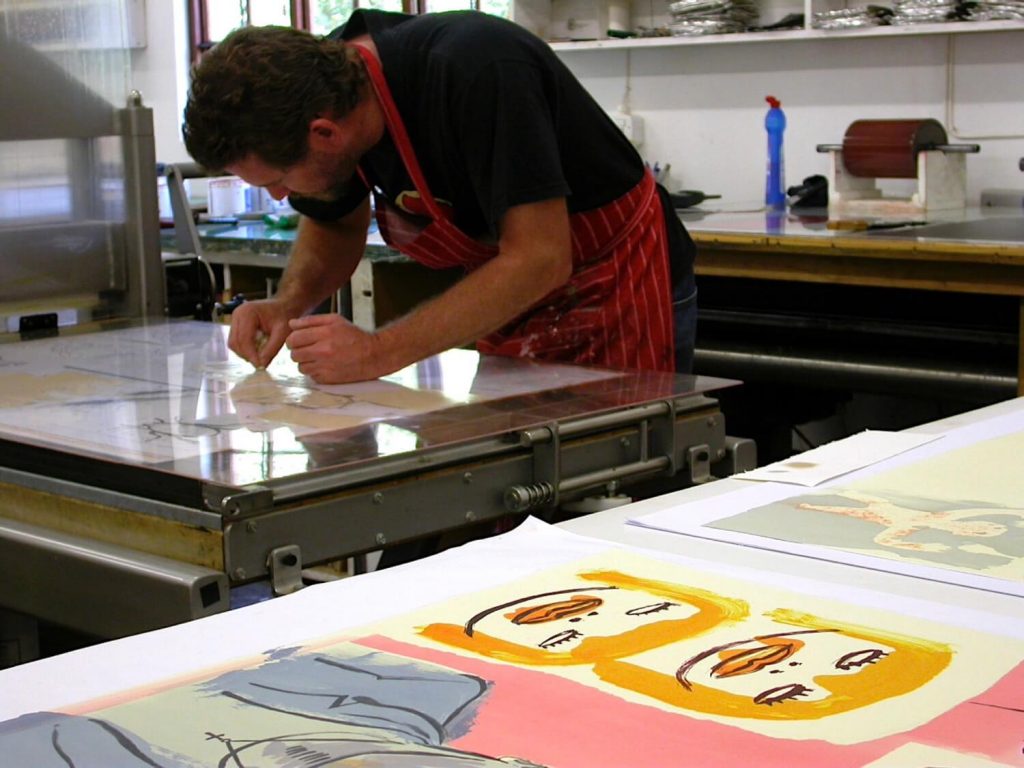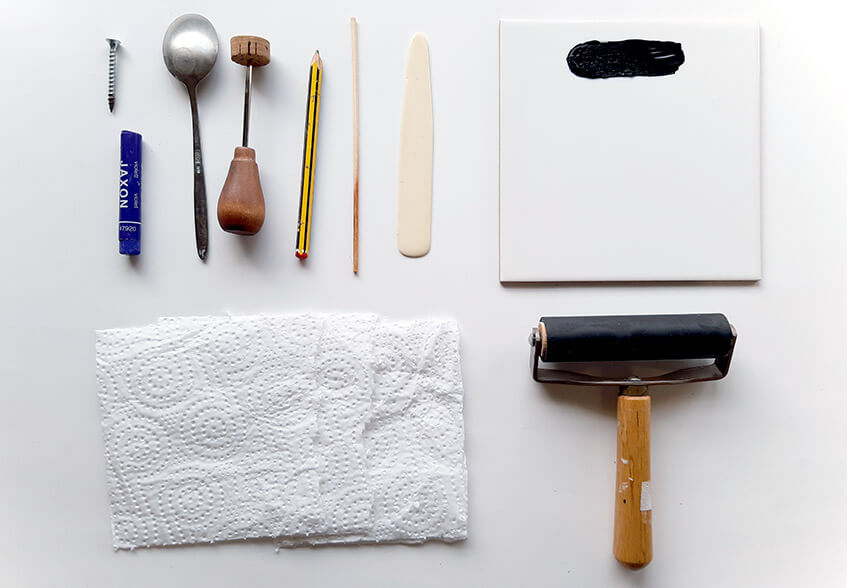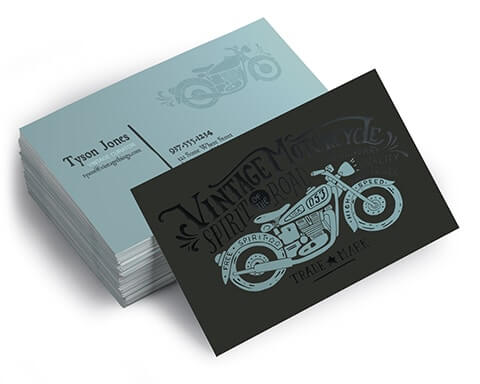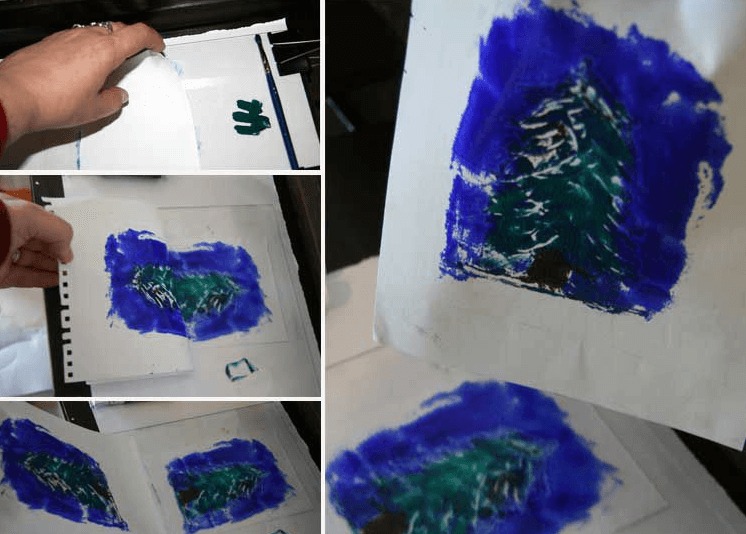Art itself is a unique thing. And when it comes to mono printing, it’s a true one-of-a-kind thing that you will really find amazing. Amazing in a sense, none of the mono print pieces can ever be exactly replicated.
What happens when we think about printing? We generally think of hundreds of papers, clothes, or any printing items coming out of a machine with the exact shapes and outlooks, right? But this unique and vintage mono-printing technique is essentially an original work of art.
What is Mono Print?
Simply speaking, mono-printing is a way of printing images using ink. This requires a machine or hand press to transfer the image from the plate to the paper. In this special way of printing, you can make just one copy of artwork at a time. Sometimes, blocks, cloths, leaves, or different materials are placed over the plate to make unique designs.
Mono printing is admired among artists for it gives ample opportunity to express one’s creativity. Highly flexible, there are no hard and fast rules in working with a mono print. You are left in a world of art lab where experimentation is just another typical day at the office.
Note, the term ‘mono print’ and ‘monotype’ are used conversely to refer to the same work. But there is a subtle difference. ‘Mono print’ actually refers to a series of almost similar works, whereas “monotype” is the true one-off.
The History of Mono Print and How It Gained Popularity
The history of monoprints can be traced back to the sixteenth century. Famous back then, painter and printmaker Hercules Seghers (1589-1638) was one of the first artists who took the liberty to experiment with ink and paper.
He practiced unique, singular prints from a single etching plate rather than a series of numbered editions. Later, the English poet William Blake, in the nineteenth century, experimented with oil and tempera monoprints. However, monoprint flourished among modern-day artists back in the late ’90s.
Modern-day artists were perhaps looking for something to express their uniqueness and spontaneity through a medium that would be quite unpredictable, something far different from the traditional printmaking process. This is where monoprint stands out – promoting the unpredictability of art and the artist!
Different Techniques of Monoprinting

Mono printing techniques have been reviewed and recreated over time. Artists do still experiment with their mono-printing techniques to yield something different and better than before. However, there are so many mono-printing techniques and methods, and you will always find shared features among them. From the numerous mono-printing techniques, check the most commons ones below –
Direct Printing
Direct printing is the most straightforward and widely used technique of mono-printing. It is a method of painting directly onto a printing surface. It requires a piece of plexiglass, such as a ceramic slab roller, or a smooth hard surface.
Artists use different texture materials such as leaves, lace, and doily to create a variety of patterns too. After the surface is ready the painted surface is directly pressed into paper to transfer the image. This method is admired by beginners as it allows a lot of creative freedom with a world of endless effects. Direct printing is also called transfer drawing.
Relief Printing
Relief printing is almost similar to direct printing. But here, the print is “designed” rather than “painting” on the printing surface, leaving a relief mark on the images. For instance, artists carve designs into blocks of materials, such as wood plates or linoleum. Then they apply a layer of ink to the surface of the block and press it onto a piece of paper. Relief printing is more time-consuming and requires several specialized tools. On the other hand, the direct printing technique is a more straightforward option. However, relief print is ideal for printing multiple images.
Transparency Printing
A transparency monoprint technique involves the use of a transparent film or acetate sheet as the source of the printing plate, such as adhesive sheets or contact paper. They are available at most office supply stores or online. During a transparent printing process, artists either paint or apply ink onto the transparent sheet and then press the printing plate to a piece of paper.
Transparent monoprints are mirror images, which are typically used for smaller prints. One can use the print multiple times before adding another layer of ink while printing using the transparency monoprint technique.
Intaglio Printing
Instead of wood or acetate sheet, intaglio printing involves the method of etching a design into a metal plate. You can say it’s sort of the extreme technique of monoprint. Metal printing plates are usually made of copper or zinc, sometimes brass is also used. Artists first apply ink on the entire plate and then wipe away the ink, leaving ink only in the engraved areas. Later, a piece of paper is placed over the plate, and a press is applied using a press machine to print the image on the paper.
Gel Palate Printing
Similar to intaglio printing, gel palate mono-printing is a unique technique to do your artwork. While intaglio printing involves the use of a metal plate, gel palate printing involves a gelatinous plate, usually made of a gel-like substance such as gelatin or acrylic gel medium as the printing surface.
Gel palate printing is more flexible compared to the other mono-printing techniques. You can use several types of ink or paint, including water-based or oil-based materials. Besides, it can be reused and cleaned easily.
Stencil Printing
Stencil printing is an easy way of creating monoprints. Artists either use a pre-made stencil or make a stencil on their own by cutting a design into paper or polythene. Ink or paint is applied on the stencil and then pressed onto paper to create the artwork. Note, if you use polythene to make the stencil, you will be able to use it again, while a piece of paper will be unusable after a few rounds.
The Standout Features of Monoprint: The Comparison Between Monoprint and Other Printing Techniques
The key features of the monoprint technique include its simplicity and beginner-friendliness. Besides, you will need basic knowledge of painting and a few easy-to-access tools to make your first monoprint. Monoprint is unique, open, and always gives the liberty to artists to explore the world of imagination.
Compared to other printing techniques, a monoprint is a really one-off-a kind. For instance, monoprint does not allow an artist to print a bulk amount of paper. While screen printing, lithography, or even intaglio printing comes with a great reproducibility option, you are only able to print one unique piece of print at a time while using the monoprint technique.
The monoprint technique is relatively speedy and brings results faster compared to other printing techniques such as screen printing, lithography, drypoint, or aquatint. This makes it really ideal for artists who love to get their work done quickly!
While most printing techniques are colour and detail-oriented, the monoprint technique rather focuses on the individuality of an artwork. Artists are not bound to get details or precise colours and lines while using monoprint techniques. On the other hand, the likes of Lithography, Screen Printing, or Intaglio printing require more accuracy, time, and skill for the creation.
Materials and Tools Used for Mono Printing

To begin with, you will not need some materials and tools to create your first artwork. There goes some of the basic materials and tools needed for mono printing.
Paper
Since the paper undergoes a lot of stress during the mono-printing process, you should use thick and sturdy paper to prevent it from damaging during the printing process. Your paper needs to absorb the ink and sustain the wet at the same time.
The BFK Rives or Stonehenge printmaking paper, Arches or Fabriano watercolour paper, drawing paper, and Japanese Hosho or Kozo paper are some of the good options for a monoprint. However, the type of ink you are using highly determines the paper you should use while monoprint.
Ink or Paint
Oil-based, water-based, and acrylic are some of the commonly used ink types for monoprints. However, there are some combinations of ink and paper in mono-printing that yield a better result. For instance, I would recommend you use oil-based ink on damp paper to get a unique texture.
If you want to print on dry paper, use watercolour or gauche to create a soft and translucent effect. On the other hand, Acrylic paint is best if you work with a Plexiglass, it gives a bold and graphic print on the paper.
Besides, oil-based ink on vellum or tracing paper is best for spreading the ink to the entire paper like a bleeding effect. Lastly, you may use a combination of water-based ink and rice paper for quickly absorbing delicate print.
Plate
A plate is one of the crucial materials used for a monoprint. The result of your print and the technique of the print largely depends on the plate you opt for. For instance, a styrofoam plate is best for a textured or embossed appearance in your final print. A gel plate is ideal for abstract prints.
Plexiglas is the most used plate, and it is admired by the artist for its durability and multi-functionality. Compatible, it can be used with oil-based or water-based inks. Besides and can be etched, painted, or drawn on to create unique designs.
Metal plates, on the other hand, are generally used for etching or engraving to create highly detailed designs. Glass plates are popular for bringing a glossy finish to the print. Besides, wooden and different other plates are also used while making monoprints.
Brayer
Brayer is also called a roller, which is used to spread the ink or the pain evenly on the plate or the surface. The rubber-made brayers are usually the best want if you like to get better density in your print. You will also get foam-made brayer too. The size and densities of a brayer vary according to the type of print you will make.
Stencils
Monoprint stencils are basically the shapes and patterns you are going to add to the print. You can make it out of paper board, plastic, cloth, or literally any other materials.
Note here, besides these important tools and materials, you also need cleaning supplies like water, mild soap, and a soft cloth or sponge to clean the plate and brayer. Some mark-making tools such as pencils and pens, and cutting tools like scissors and print press will also come into action while making monoprints.
Monoprinting Process: A Quick Step-by-Step Guide
As you have come this far, you already know that mono-printing is not a difficult task. Here is a quick guide to your first monoprint.
- Get your printing materials on the table or a smooth surface
Get the necessary materials such as plate, ink, paper, brayer, stencils, and wooden or printing press in one place. A flat and smooth surface such as a table is the ideal place to work with your monoprint.
- Prepare your ink on the plate using the roller
Once you have everything at your disposal, let’s start with preparing the ink. Put your desired ink on a flat surface. Note here, do not apply ink directly to the plate. First, put a small amount in a flat trey-like hard surface and roll the roller over it continuously till the roller is totally covered in ink.
Tips: You can use medium or relatively fine sandpaper, such as 120, to rough up the surface of your plate. This will create additional teeth to the plate and allow a better colour effect to the print.
- Roll a thin layer of ink evenly over the plate
Ensuring your brayer or roller has an adequate amount of ink, it’s time to evenly distribute the ink over the plate. Avoid applying too much ink, otherwise, it might get messy. Use a different brush if you are applying multiple colours to your print.
Tips: Marking the edges of the reference paper over the plate will save your ink.
- Create your desired design using different techniques
With your plate ready with ink, you can give the final touch by creating your desired design. Use pencils to make lines. Use paintbrushes to draw your images. You can use tree leaves, flower petals, or different textured objects to create shapes.
- Place the paper over the plate and apply the press
Place the paper over the plate. It’s important to align your paper correctly over the plate to utilize most of the ink and get a better result. Apply press over the paper to transfer the image from the plate.
Tips: You can use a wooden spoon or bare hand to do the pressing job too. Drawing over the back paper using a pencil while it is attached to the inked plate can also add extra effect to your printing.
- Lift the paper and add the final touch
Sometimes, paper can stick to the ink firmly. So, it is necessary to carefully lift the paper from the plate. Start at one corner and gently peel the paper away from the plate to avoid tearing.
Tips: Applying even pressure while pressing and using thick paper can prevent tearing while lifting the print.
Application of Monoprinting: From Personal Pleasure to Custom-Made Business Card

Yes, it is true that the nonprinting technique is typically used for pleasure purposes. But the application of mono-printing also travels various artistic disciplines such as fine arts, illustration, textile design, or even card making.
Pieces of monoprint works are often displayed in art galleries and sold at high prices for their unique, one-of-a-kind quality. Monoprints are also found in book illustrations for their bold, graphic effects with a touch of hand-made feelings.
Don’t get surprised to hear that monoprints techniques bring great results in textile designs collaborating with other printing techniques such as screen or block printing. Besides, there is a high demand for handmade card making where mono-printing flourishes.
Well, still need more motivation? Here are two of the great artists and designers who got famous using monoprint techniques-
The name Edgar Degas comes at the top of the list when we talk about great monoprint artists. His lifelong passion for capturing the “human form in motion” through his monoprint artworks gained him popularity during the 19th century.
Check out some of the greatest works of Edger Degas here.
Robert Rauschenberg is another renowned personality whole made mono printing famous in the US. He is known for his thirst for using different printmaking techniques, including mono-printing. He used collage elements in his monoprints widely. He continued working with monoprints till his death in 2008.
Advantages and Disadvantages of Mono Printing Compared to Other Printing Techniques
People like mono-printing because it’s relatively simple and affordable. You can access and achieve this technique regardless of your expertise on this subject. Besides, there are only a few pieces of equipment required to print your first mono-print at home.
The monoprint technique is more eco-friendly compared to other printing techniques. It uses water-based ink and makes lesser waste ensuring a healthy environmental balance.
Besides, the use of chemicals in monoprints is significantly less than in etching and lithography, where additional chemicals are used to create images in the printing plate.
| Advantages | Disadvantages |
| Uniqueness | Unpredictability |
| Does not require huge expertise | Does not allow reproduction |
| Flexibility | Limited colour option |
| Ideal for experimentation | Messy process |
| Requires fewer equipment | |
| Inexpensive materials | |
| Environment friendly |
The Final Touch
As the demand for experimental printing techniques rising all around the globe rapidly, the future of monoprint looks really promising. Taking the environmental concerns into account, the mono-printing technique can be a highly sustainable option for printmakers to whom nature really matters.
One can question the disadvantages like difficulty in reproduction, a messy old-style process in this process, and the lack of a linear style of printing in the monoprint technique. But the greater flexibility in experiment and ease of access makes monoprint a popular option for creating a distinctive print.

Hi! I’m Jon Tabner, I am a Graphic Designer and Marketing Executive in profession. Exploring new things, innovation and designing is my passion. Now working as head of Graphic Designing & Marketing Executive team at Print In London and currently I am based in London. I love using my design knowledge to inspire small businesses to think outside the box when designing their print.

